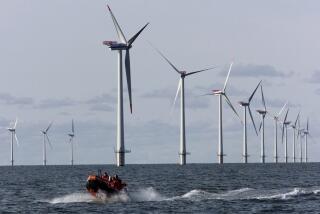County Rejects Scaled-Down Wind Farm Plan : Energy: The project would have put 145 windmills on 580 mountainous acres near Gorman. Opposition included environmentalists who feared that birds would be killed in the blades.
- Share via
The Los Angeles County Board of Supervisors rejected a plan Thursday to build the county’s first power-generating wind farm in the hills northeast of Gorman, despite a 68% reduction in the size of the project since it was proposed three years ago.
The board, siding with surrounding landowners and environmental groups, concluded that the wind farm would blight the scenic slopes, promote erosion and threaten birds--particularly the endangered California condor--with its whirring blades.
The only remaining condors are in captivity, but the species could be reintroduced to the region in the early 1990s.
The board’s action upheld an August, 1989, decision by the county Regional Planning Commission, which refused to grant a conditional-use permit for the project, citing the same grounds.
The developer, Zond Systems of Tehachapi, the largest producer of wind energy in California, appealed that decision and presented a dramatically scaled-down version of its original plan to the supervisors Thursday. Zond reduced the number of windmills from 458 to 145 and the total acreage of the project from 1,630 to 580.
Zond President Kenneth Karas told supervisors that the windmills, some as tall as 150 feet, would no longer be visible from the Golden State Freeway or the surrounding communities of Gorman, Lebec, Frazier Park and Peace Valley.
Only those motorists traveling along California 138 would see them, Karas said.
But the board, acting on a motion by Supervisor Mike Antonovich, voted 3-0 to deny Zond’s appeal. Supervisors Deane Dana and Pete Schabarum were absent.
“I believe that wind energy is a viable alternative source of energy and ought to be pursued,” Antonovich said. “However, after listening to testimony today, it is clear that reducing the number of generators will do little to address the problems in this proposal.”
The project was backed by the influential Ralphs family, a pioneer Gorman family that founded the supermarket chain.
However, it drew opposition from a broad coalition that included the National Audubon Society, the Sierra Club, a citizens group called the Save the Mountain Committee and Tejon Ranch, a company with 200,000 acres in the area.
“Wind farms in the wrong places can be fatal to great numbers of birds,” said Linda Blum of the Audubon Society. Property owner Jack Spahn was more concerned with its visual impact, saying: “The view of this tin jungle would be a hazard to us.”
After the board vote, an angry Karas criticized Tejon Ranch, which he characterized as the project’s major opponent. “What we have here is one developer against another,” Karas said. “But one is wrapping itself in the flag of environmentalism.”
Zond’s $100-million project would have harnessed enough wind to generate 84 million kilowatt hours of power a year, enough to serve 13,400 homes without increasing air pollution, company officials said. Over 30 years, it would produce the energy equivalent of 4.85 million barrels of oil, they said.
Karas disputed contentions that the project would endanger wildlife. He said the windmill blades would rotate so slowly that birds could see and avoid them, causing no more than seven bird fatalities a year.
Robert Thayer, a professor of landscape architecture at UC Davis, said the primary objection among the 1,000 people he queried about wind farms was aesthetic. Although people generally embrace the concept of wind farms, he said, “it follows a ‘not in my back yard’ type response. . . . I think it says that people in the L.A. region have yet to realistically grapple with the energy they consume and the sources of that energy.”
More to Read
Sign up for Essential California
The most important California stories and recommendations in your inbox every morning.
You may occasionally receive promotional content from the Los Angeles Times.













